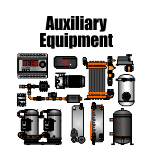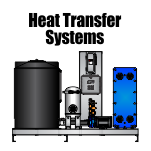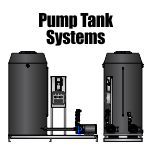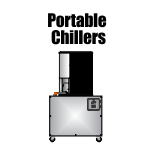Equine Spa Chillers
Benefits of a Whaley Freeze-Free Chiller System over conventional equine cold spa chiller design:
- In horse cold spa applications, sound output from the chiller system matters given the fact horses could be nearby at all times. The sound level of our unit would be equivalent or better than existing conventional chiller systems. Whaley’s chiller systems utilize vertical discharge air flow design, which allows the fans to emit significantly less decibels compared to horizontal discharge conventional design. If sound has been or will be a major factor for a given installation, with Whaley’s new chiller system design you can move the chiller system outside of the barn, and move the glycol-to-cold spa water titanium heat exchanger inside the building next to the spa in order to move 100% of the noise outdoors away from the spa entirely.
- Titanium has the best chemical resistance of any heat transfer medium available on the market. Whaley’s new design utilizes a titanium material for the heat exchanger instead of cupre-nickel or brazed plate which will allow cold-spa owners to never worry about corrosion of the heat transfer media, and will also allow the cold spa owner to experiment with other various spa water chemistry such as bromine solutions, which would corrode the alternatives if used at too high a concentration.
- Another issue equine cold-spa owners have experienced is that their chillers could not keep their spa at 35F when a high volume of horses needed to move through it in a given day. In order to solve this issue, Whaley offers a stackable all-in-one design which incorporates up to twice the capacity of a conventional chiller system still at single phase 208-240 voltage, which is the voltage typically required for cold-spa barn installations. Twice the capacity, but not twice the cost.
- Whaley can adapt to the farm’s requirements. Cold-spa side pumps, filtration, and other various components can be provided factory mounted on the chiller unit to allow simplicity of incorporation in new systems and also retrofit installations.
- Whaley can heat trace the titanium heat exchanger as well as insulate all heat exchangers, piping, hoses, fittings, and flow switches for added freeze protection during cold winter months.
- Whaley can offer custom configurations depending on the location. If a customer has a climate controlled facility, but does not want the heat to be dissipated indoors, there are several ways Whaley can manufacture the system at the same cost to allow the heat to be dissipated outdoors. Another common cost-less customization on our system is for the titanium heat exchanger to ship loose for field installation indoors in a climate controlled barn for added freeze protection.
- Whaley factory tests every unit extensively before it ever leaves our facility to ensure quality and consistency. See more at this link: http://www.waterchillersystems.com/whaley-unveils-whale-soft-all-new-elaborate-equipment-testing-quality-standards-system/
- Whaley has been in business for over 20 years and has an extensive reputation for designing fail-proof solutions for product line voids in a variety of industries. We serve many applications and many clients ranging from military, government, universities, fortune 500 companies, and many more.
With Whaley’s new equine spa chiller, we have solved all the vulnerabilities of the conventional industry design. No longer do you have to unsafely circulate your equine cold spa water directly through your chiller system’s evaporator just waiting for something bad to happen. Instead, utilize a Whaley Equine Cold Spa Chiller with maximum freeze protection and serviceable titanium heat exchanger to eliminate vulnerability, and maximize longevity. With conventional chillers used by equine cold spa industry, the unit is designed to have the spa water circulated directly through the chiller system’s evaporator while attempting to achieve 35F leaving water temperature. There are 3 critical vulnerabilities of this conventional design that currently leaves equine spa owners’ chiller systems susceptible to failure and destruction. This failure and destruction comes with a considerable replacement cost to the owner if any of these below unfortunate scenarios or situations occur.
#1 Vulnerability relates to any installation where your ambient temperature can fall below freezing, which would be the vast majority of the United States and Canada.
- The evaporator is essentially the heat exchanger in any chiller system which transfers the heat from water to the refrigerant system. As said previously, in conventional designed chillers the unit is designed to have the spa water circulated directly through the chiller system’s evaporator. This type of design puts the system in a vulnerable situation during winter with regards to freeze issues if the chiller is located outdoors or in a non-climate controlled barn. The solution many chiller manufacturers have given for this issue is to run your spa water pump 24/7 to constantly keep water flowing through the system to not freeze the chiller, and also incorporate an inline flow switch into the system design. The truth is in the middle of winter, a simple power outage or failed spa-side water pump and flow switch in the middle of the night could lead to freezing your chiller’s evaporator, contaminating your refrigeration circuit with your spa water, and consequently destroying the entire chiller system.
With Whaley’s new chiller system design, even if the power goes out in the worst winter conditions, the chiller system’s evaporator will be safe from freeze-up issues no matter what the circumstances.
#2 Vulnerability relates to the target spa water temperature.
- The vast majority of equine cold spa facilities need their spa water cooled down to 35F, but not to exceed 40F. With conventional chiller design, the unit is designed to circulate the spa water directly through the chiller system’s evaporator, which is the key component where the heat is transferred from the spa water to the refrigerant. The issue is that the refrigerant runs around 25F in order to achieve the 35F spa water temperature. Given the fact there is straight water going through the evaporator, crystallization and subsequent freezing of the evaporator can be common at these temperatures. The solution chiller manufacturers have given is to pump a higher flow rate through the evaporator, use larger connection sizes on the evaporator, use a larger pipe diameter, and incorporate an inline flow switch in the loop feeding the evaporator. There are 3 vulnerabilities with this type of recommendation that if occurred, it would not take long to freeze the evaporator.
- If the inline filter’s screen or filter bag is full enough to partially slow down flow enough to the chiller to the point of temporarily starving the chiller of the required flow it needs, but doesn’t hinder the flow quite enough to trigger the flow switch to de-energize the compressor. This could easily lead to freezing of the evaporator.
- If some debris gets past the filter and happens to partially clog the evaporator, but doesn’t clog enough to trigger the flow switch to de-energize the compressor. This could easily lead to freezing of the evaporator.
- If the pump fails and flow switch sticks in a closed position, this could lead to freezing of the evaporator.
With Whaley’s new chiller system design, we don’t run the horse cold spa directly through the chiller system’s evaporator, because you never should if you need 35F spa water temperature. On Whaley’s new unit, the cold spa water is ran through a glycol-to-cold spa water titanium plate & frame heat exchanger which is designed to run at these lower temperatures and not freeze up and bust. The chiller system side is protected with a food-grade propylene glycol which keeps the chiller system’s evaporator from freezing up no matter what bad scenario conditions you put it in from the above mentioned unfortunate scenarios list.
#3 Vulnerability is the fact that once you clog the chiller system’s evaporator, it’s a coin toss whether you are going to get it un-clogged.
- Sometimes you can flush the evaporator one way, then try flushing it backwards as well. You can also try using chemicals to flush through the evaporator to try to break up debris. The fact of the matter is that sometimes you cannot remove full or partial blockage, which would force the cold spa owner to need to replace the evaporator, or even the entire chiller if the clog led to a freeze up of the chiller system and subsequent contamination of the refrigerant circuit with spa water.
With Whaley’s new chiller system design, if the glycol-to-cold spa titanium heat exchanger happens to get clogged from horse spa debris, it can be easily taken apart for cleaning and maintenance in the event flushing, back flushing, and chemical flushing don’t unclog it. This is a major benefit compared to the conventional design which does not allow you to take the evaporator apart to clean and maintain it because it is sealed.

























